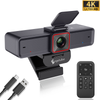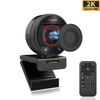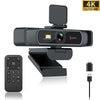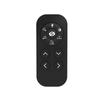
When selecting an Angetube webcam for live streaming, consider the following aspects from Angetube's comprehensive guide:
- Resolution and Frame Rate: Choose a webcam with at least 1080p resolution and 30 fps to ensure crisp and smooth video playback.
- Lens Quality and Field of View: Opt for a glass lens for better image quality and choose the field of view that suits your needs – wider for more surroundings or narrower to focus on you.
- Autofocus and Light Correction: Look for features like autofocus and automatic light correction to maintain clarity under different conditions.
- Built-in Microphone: While a dedicated microphone is better for professional quality, a built-in one can suffice for casual streaming.
In looking for a webcam, consider the following:
- Key Features: Resolution (at least 1080p), frame rate (30 fps or higher), lens quality (prefer glass), field of view, autofocus, light correction, and whether it has a built-in microphone.
- Expert Tips: Determine the webcam's purpose, whether for casual or professional streaming, and select features accordingly. Consider the setup, including placement, lighting, and background.
- Top Recommendations: Angetube's range likely includes specialized webcams for different streaming needs, such as gaming, professional broadcasting, or casual chats.
When selecting an Angetube webcam, you need not prioritize 4K resolution or 60fps if your primary use is for live content on platforms like Twitch, Zoom, Teams, and WebEx, which only support up to 1080p at 30fps. Higher resolutions are beneficial for content that will be published for viewing later, not for live streaming. Focus on other features that will enhance your live streaming experience, such as lens quality, field of view, autofocus, and light correction.
Selecting the Ideal Field of View for Your Webcam
Understanding the field of view (FOV) is paramount when choosing a webcam, as it shapes your virtual interaction landscape. A wide FOV, typically 100° or more, offers an expansive view, enriching communication with broader visual context — ideal for sign language or group participation.
Conversely, a narrow FOV, within 70°–85°, provides a focused frame, perfect for solo presentations or when you wish to share less of your surroundings. This option suits smaller rooms or situations where background activity is to be minimized.
For versatility, consider a webcam that boasts zoom capabilities or one that sits comfortably in the middle range of 85°–100° FOV. This flexibility allows for adaptability across various environments and uses, ensuring your webcam serves as a reliable portal for all your online engagements.
Navigating USB Connectivity for Your Webcam
When it comes to webcam connectivity, USB type is a detail that cannot be overlooked. The majority of webcams on the market are equipped with USB-A cables, which are compatible with the common USB-A ports found on many computers. If your machine sports only USB-C ports, you'll need to be discerning in your search for a webcam that matches.
For webcams advertised as USB-C compatible, it's crucial to confirm that the cable included has a USB-C connector on both ends, as some may have a USB-C on the webcam side but offer a USB-A connection for the computer side.
If your preferred webcam only has a USB-A cable, there's a simple solution: acquiring a USB-A to USB-C adapter. This additional purchase will bridge the gap between your webcam and computer, ensuring seamless connectivity regardless of port type.
Choosing the Right Cable Length for Your Webcam
The length of your webcam's cable is a crucial aspect of your setup, requiring careful consideration. To ascertain the necessary cable length, measure the path from your computer to where you intend to place your webcam. Typically, webcam cables range from 4 to 7 feet, sufficient for standard desk setups.
Should your setup demand a more extended reach, select webcams offer cables that approach 10 feet, providing that extra span for more distant or complex configurations. For those with highly specific length needs, opt for webcams featuring removable cables. This flexibility allows you to substitute the original with a longer power cable, fitting the exact specifications of your workspace.
Understanding Sensor Size in Webcams
The sensor size in webcams is a pivotal factor that influences image quality. A larger sensor size means more light can be captured, which translates to images with greater detail, better contrast, and richer colors. This capability is particularly beneficial in low-light conditions, ensuring clear and high-resolution visuals.
In contrast, webcams with smaller sensors may not be as adept in variable lighting but can still produce quality images when the lighting is favorable.
Sensor sizes are typically denoted by a fractional inch measurement, such as 1/2.5". In this notation, a larger fraction signifies a bigger sensor size, which corresponds to enhanced light capture ability. When selecting a webcam, considering the sensor size can be a key to achieving the image clarity you desire.
Maximizing Webcam Performance with Sony STARVIS Sensors
The current pinnacle of webcam sensor technology is the Sony STARVIS, boasting a sizable 1/1.8” sensor. Originally engineered for security cameras to capture high-quality footage in nocturnal conditions, STARVIS sensors are now enhancing webcams, setting the standard for impeccable video quality in low-light environments typical of home offices.
The superior STARVIS 2 sensor is employed in the Iris, ensuring the brightest and sharpest video quality for users. Additionally, the original STARVIS sensor is integrated into other 4K camera offerings, providing a professional-grade video experience that excels in capturing fine details even when lighting is less than ideal. The adoption of these sensors in webcams represents a significant leap in image processing, delivering unparalleled clarity and color accuracy.
Choosing the Right Privacy Cover for Your Webcam
Privacy covers are a standard feature for webcams today, offering an extra layer of security. However, since they're often not removable, it's important to select a webcam with a privacy cover that meets your preferences.
Built-In Privacy Cover
A built-in privacy cover is integrated within the camera lens mechanism and is usually operated by a sliding lever.
Pros:
- Securely attached, eliminating the risk of loss.
- Sleek design without added bulkiness.
- Offers a sturdy, less breakable option.
Cons:
- Small levers can be finicky to use and may stiffen over time.
- A black cover can make it difficult to visually confirm if it's closed.
- Non-removable, limiting flexibility if you wish to use a different cover type.
When considering webcam options, the type of privacy cover is as crucial as the technical specifications, as it contributes to both the functionality and security of your device.








 Angetube 913
Angetube 913
 Angetube 866MAX
Angetube 866MAX
 Angetube 914pro
Angetube 914pro
 PTZ 4K 871Ai
PTZ 4K 871Ai
 Angetube 863plus
Angetube 863plus
 Angetube @60FPS 873Ai
Angetube @60FPS 873Ai
 Angetube 967Pro
Angetube 967Pro
 Angetube 967
Angetube 967
 Angetube 862pro
Angetube 862pro
 Angetube 920
Angetube 920
 Angetube 963
Angetube 963
 Angetube 962
Angetube 962
 Angetube 827
Angetube 827
 Angetube 628
Angetube 628
 Smart Notebook
Smart Notebook
 862Pro
862Pro
 863PLUS
863PLUS


